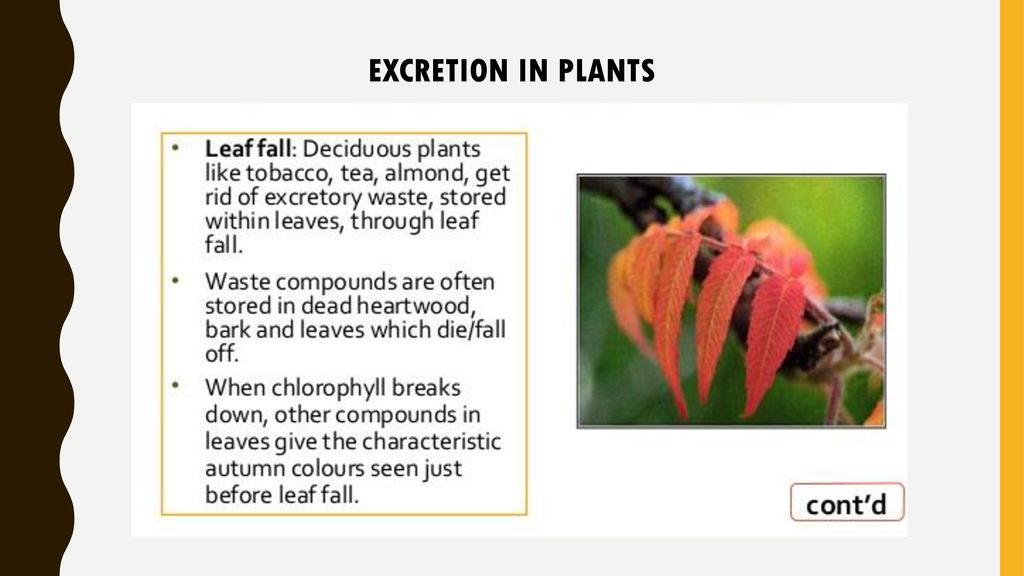Plant Excretion Definition
Excretion in plants is the removal of unwanted substances from the plant system. Excretion in plants and animals are similar, however, excretion in plants has distinct characteristics that are different from that of animals.
This is because the mode of excretion in plants or the mechanisms of excretion in plants is not to be compared with man or other animals.
Animals have special and well-organized structures as excretory organs but plants do not have special excretory organs. However, they have special devices for getting rid of their unwanted materials.
What are the excretory products of Plants?
The main waste products formed in plants are water, carbon dioxide, and oxygen, while tannin and a few others are of secondary importance.

Examples of Excretion in Plants
Carbon dioxide
Carbon dioxide is formed as a result of respiration which takes place at all times in all living cells.
On the other hand, oxygen is released only in the daytime as a by-product of photosynthesis.
The rate of photosynthesis is many times greater than that of respiration. Hence, the carbon dioxide produced as a result of respiration is used up completely by the chlorophyllous cells for photosynthesis.
In addition to this, carbon dioxide from the atmosphere has to be absorbed by these cells in order that the process of photosynthesis may continue.
Oxygen
Only a small quantity of the oxygen produced by photosynthesis is used up for respiration.
The excess diffuses from the leaf into the air outside. At night, photosynthesis does not take place.
Oxygen from the atmosphere is used for respiration and carbon dioxide is released as a by-product.
In general, it can be said that green plants give off oxygen as a waste product in the daytime, and carbon dioxide at night.
Water
Water in a plant is obtained largely from the soil. a very small percentage comes from chemical reactions that go on in cells, for example, respiration.
Any excess water in the plant is removed as water vapor by the process of transpiration which, therefore, has an excretory function.
In certain plants, for example, tomato, potato, cabbage, and a few types of grass, the excess water is also got rid of in liquid form at the tips and margins of leaves.
They enlarge and eventually drop off. This process, which is known as guttation, occurs when too much water is absorbed by the roots of a plant and when transpiration does not occur rapidly enough to get rid of excess water.
Excess Minerals in Plant Leaves
Plants obtain water and mineral salts from the soil. Most of the mineral salts that come in with the soil water are made use of by the cells to manufacture various types of organic substances.
The excess mineral salts are stored in certain parts of the plant body and got rid of when these parts die and drop off.
Crystals of calcium oxalate and calcium carbonate are examples of waste products stored in the cell vacuoles and cell walls of certain leaves.
Other waste products of Plants
Waste products other than water, carbon dioxide, and oxygen are usually taken out of contact with the protoplasm by conversion into an insoluble form.
The insoluble form of waste is usually stored as a secretion within the cell, in the cell wall, or in intercellular spaces.
A number of plant substances, like tannins and certain pigments, are considered to be waste products because they have not been demonstrated to be of any vital use of the activities of the cell.
Importance of Excretion in Plants
Sometimes, toxic substances that may have come in with the soil water are also stored away in some plant parts until they can be removed.
Similarly, some of the waste products formed as a result of respiration and other metabolic activities in cells are also stored in parts of the plant such as the leaves, fruits, and sepals of flowers, all of which can be shed after some time.
Examples of such waste products are glycosides ( compounds containing sugars), tannins, alkaloids (poisonous nitrogenous compounds), and plant oils.
- Glycosides include digitalin from foxglove ( used for treating heart diseases),
- Sarsaparilla from Smilax ( used for flavoring drinks), and
- Anthocyanin pigments, which give red, blue, and violet colors to many flowers.
Economic Importance of Plant Wastes
Tannins are found in the cell sap, cell wall, and most abundantly in dead tissues like the bark and woody tissues of certain trees, for example, Oaks, mangroves, conifers, and chestnut.
Sometimes tannins are stored in leaves ( for example tea leaves) and fruits ( for example plum and persimmon).
Some tannins have been shown to be glucosides ( compounds containing glucose).
Alkaloids include useful products like morphine from the opium poppy plant papaver, quinine from the Chinchona tree, and cocaine from the coca plant.
Cinnamon from the cinnamon tree, eucalyptus from the eucalyptus tree, turpentine from the pine tree, and camphor from the camphor tree are some examples of commercially important plant oils.
Certain plants produce secretory products like latex ( for example, rubber and guayule),
Resins ( for example pines),
Gums and mucilages ( for example Acacia, Okro (lady’s fingers), and Hibiscus).
These products are secreted by special cells or glands in the plant body.
They are usually found in special canals or ducts and ooze out of the plant when some part of it is damaged, but are not ordinarily excreted.







